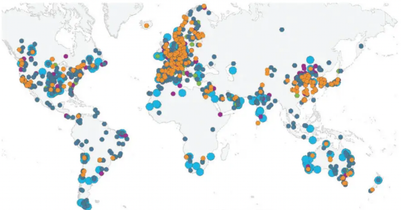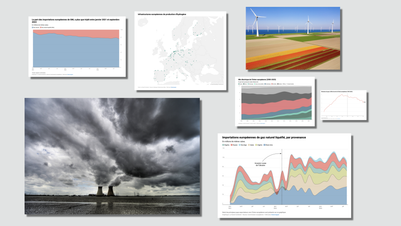article-en
July 6, 2023
Hydrogen: regulators must resolve uncertainties as quickly as possible!
It is imperative that European policy makers quickly define and implement clear, definitive, and binding standards around hydrogen and that the US creates comparable methodologies and taxonomy, to avoid losing investors in this critical piece of the transition jigsaw.
Inflation, the rule, and the market…
Hydrogen’s crucial role is now widely recognized as part of the energy transition and urgent need to reach net zero. This is leading to a significant increase in demand for the fuel. The number of new projects announced every week bears witness to this and reinforces the promise of deployment. According to the World Hydrogen Council’s latest report, “Hydrogen Insights 2023”, hydrogen momentum has almost doubled in the space of a year, with over 1,000 projects announced to date, representing $320 billion of investment worldwide. The most compelling opportunities range from the decarbonization of existing uses (ammonia, refining), to the switch to clean processes in energy-intensive industries (cement, pulp, glass, etc.) or reducing agents (steel industry). Initiatives and projects in heavy and intensive transport sectors are also being developed, with the first effects of scale anticipated in the second half of this decade.
However, this dynamic is hampered by two phenomena: firstly, the impact of higher inflation on costs, and secondly, indecision and final investment; the ratio of firm decisions to intentions remains stable at around 10%, which is unsatisfactory.
Some of this inflation cost can certainly be explained by the effect of general price inflation on the value chain. Paradoxically, it is also due to the measures taken to counter it.
First and foremost, inflation impacts costs across the entire renewable ecosystem.
It impacts project investment costs. According to the International Energy Agency, the investment cost of building new onshore solar and wind capacity has risen by 15-25% between 2020 and 2022, after a decade of decline.
Secondly, the rise in interest rates to counter inflation is impacting the full cost of electrons and, by extension, green hydrogen.
The green energy economy (including hydrogen) is extremely capital-intensive. The proportion of costs directly impacted by rising interest rates is considerable, since in a totally “green” value chain, most of the cost is capital, with very few operating and variable costs. The rise in interest rates over the past few months has thus driven up the cost of new renewable projects. It can be estimated that an increase in project financing rates from less than 2% to over 5% mechanically raises the cost of electrons produced by these new projects by 20% to 30%, depending on financing assumptions. The accumulation of those two effects – inflation on projects and interest rates on yields – raises the electron cost price (LCOE) by over 40%!
The third inflationary pressure on the hydrogen economy reflects the current profound market mismatch between supply and potential demand.
This situation is fueled by the delay in implementing the rules and public policies that should enable investors, manufacturers, and developers to move projects to the decision-making stage. The result is a further rise in project costs just as the market had been expecting the price of green hydrogen and hydrogen projects to drop. At the same time, the return of European natural gas to levels seen before Russia’s invasion of Ukraine has given a new lease of life to carbon capture projects. This is good news for wider industry, which needs to stand on its own two feet to deploy low-carbon solutions worldwide, but it also contributes to indecision on where to spend capital on transition.
The market is stalled by the lack of clarity as to which future low-carbon models will be favored and regulated.
Yet “Climanomics” seems to be in full swing. The main parameters of a gigantic, quasi-global operation to reorient finance and investors towards “virtuous assets” are green in the intentions of the world’s major economic zones. In Europe, this reorientation is based on the Taxonomy and the Sustainable Finance Disclosure Regulation (SFDR), the Renewable Energy Directive (RED) and its corollaries for transport (road, sea, and air), together with a bewildering and complex series of both Europe-wide and national plans. Meanwhile, Japan has its “GX” program, with over 200 billion euros of investment announced over the coming decade to 2033. And the green transition in the US has gained momentum following the publication of the Inflation Reduction Act (IRA), estimated at 400 billion dollars, as well as the Production Tax Credit (PTC), which could make green hydrogen as competitive as grey.
There are positive signs. But there is a time lag between will and implementation… which is deeply disruptive.
European rules are still being debated but we hope to see some conclusions in coming weeks. The outcomes will determine which decarbonization paths will be open to industrials, enabling decisions to be taken about projects for which Europe is their location or destination. The IRA, for its part, has entered the same intense debate on the forms of hydrogen eligibility for PTC, depending on the quality of the primary energy. As for the Japanese GX program, it has just begun its journey through the Japanese Imperial Diet (equivalent to the National Assembly) to be ratified.
Delays to implementing effective “Climanomics” frameworks is preventing hydrogen offtakers from firming up their projects. It’s forcing supply chains to price in uncertainty and scare capacity in project development, execution resources and manufacturing to the highest bidders, in turn fueling price rises and chilling decision-making.
As a result, the market is in a state of suspended animation, with prices rising in line with the passage of time. We see the trade-offs that suppliers and developers must make, some to price in uncertainty and scarcity of supply, others to take production slots ‘just in case’.
Meanwhile, China is moving forward! It seems to be handling the market, appetite for risk (nearly 150 electrolysis suppliers, from the very small to the largest in size, and the largest number of vehicle models listed) and speed (more deployments and actual commitments from production to use than Europe and the USA) far better than we are managing in the OECD, even though we set the course for this global dynamic.
This is an unsatisfactory situation. For the whole industry, this comes as a frustration as the market to catch is 100 times higher than today, but requires for that prices to fall 2-3 times instead of going up!
It is therefore imperative that European policy makers quickly define and implement clear, definitive, and binding standards around hydrogen and that the US creates comparable methodologies and taxonomy, to avoid losing investors in this critical piece of the transition jigsaw.

Innovating to finance the hydrogen economy
On the road to a more sustainable economy, we need more investment in sustainable assets. These investments must not only be supported by appropriate regulatory frameworks, but also encouraged and facilitated by financial mechanisms.
More about

Energy Europe – From integration to power
Europe is fragile. It's a fact: it will never have total energy independence. How can we take advantage of this situation? Pierre-Etienne Franc, co-founder and CEO of Hy24, proposes to turn a weakness into a strength - to the benefit of the Union's industrial and foreign policies.
More about

Report: Enabling CO2 standards, a policy toolkit to foster the implementation of AFIR in European Member States
The report was prepared by Hy24 with the contributions of Daimler Truck, Stellantis, Renault, Hyvia, BMW Group, Toyota, Hyundai, Honda, Air Liquide, TotalEnergies, Vinci Concessions, Air Products, Everfuel, Messer, H2Accelerate, Snam, Engie and H2 Mobility to stress the urgency of deploying the HRS network if we are to achieve the ambitious objectives set by AFIR and, more importantly, the decarbonisation targets for the transport sector.
More about
